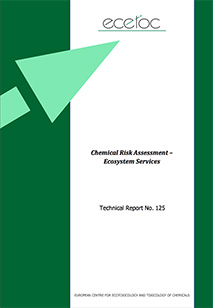Technical Report no.125 – Chemical Risk Assessment – Ecosystems Services
READ ONLINEEcosystem goods and services are the benefits we (humans) get from nature. They include provisioning services, e.g. from crops that provide food and fibre, regulating services, e.g. the plants growing in river basins that retain water and thereby reduce flooding, supporting services, e.g. the microbial communities involved in nutrient cycling and soil formation and cultural services, e.g. the aspects of ecosystems that provide spiritual, recreational and educational benefits.
Environmental landscapes are multifunctional but the range of services they provide is largely dependent on how they are managed. Managing for some services limits the delivery of others, e.g. draining land to increase agricultural yields increases food production but reduces flood alleviation. Understanding how ecosystems provide services and the trade-offs between them helps authorities decide where and how the ecosystem services needed to benefit society can be provisioned.
In addition to helping manage landscapes and communicate the benefits people gain from the environment, the ecosystem services concept also has relevance for how we assess the potential impacts of commercial chemicals that are released into the environment. It means that we can focus our assessments of potential impacts on the types of plants and animals providing the services in each type of habitat. For example, the most important species to protect in agricultural land used to grow crops would include the crop species themselves, species that control pests and diseases, microbes that breakdown organic matter to form soil or recycle nutrients, and so on. A different list of key species would come from woodlands where, although trees may be harvested for timber, they are also important in regulating water, air quality and climate. Insects, birds and mammals involved in pollination, seed dispersal and pest and disease control are all important in maintaining a thriving woodland. In principle, these spatial differences in service-providing species means we could change our basis for making chemical risk assessments from protecting all species everywhere at all times, which is the most common approach in current chemical regulation, to a more environmentally representative assessment based on types of land and water body use.
Recently, the European Food Safety Authority (EFSA) developed a framework to identify ecosystem services potentially affected by (agro)chemicals, such as pesticides, for setting specific protection goals and guiding environmental risk assessment. An ECETOC Task Force has investigated the applicability of the EFSA framework for developing habitat-specific protection goals for a wide range of other chemicals using four case studies spanning a range of different emission scenarios and habitats. The selected case studies were: i) oil refinery wastewater exposure in estuarine environments; (ii) oil dispersant exposure in marine environments; (iii) chemicals in consumer products (home and personal care and pharmaceuticals) discharged via sewers to expose a wide range of ecosystems (terrestrial and aquatic); (iv) persistent organic pollutant exposure in remote (pristine) environments. The case studies demonstrated that, with some modifications and development, the EFSA framework could be used to identify and prioritise ecosystems and services that are most at risk from a broad range of chemical exposure scenarios. Prioritised habitats with their associated plants and animals could then form the focus for further risk assessment and/or investigation to assess if control measures are adequate.

